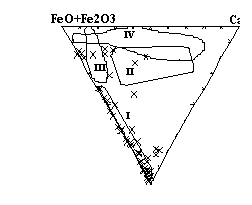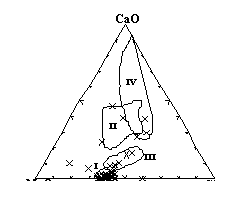

The iron ore deposits of Angara-Ilim type are polygeneous, heterogeneous, and polychronous. They are generated as a result of at least three stages of mineragenesis, marked by the complexes of magmatic, metasomatic and hydrothermal formations, including various genetic and commercial ores.
The detailed mineralogical and geochemical study has allowed to establish, that the earliest stage of ore formation in these structures is associated with the development of phoscorite group of rocks. Within the classification and nomenclature of this group of rocks, proposed by L.S.Egorov (1992), all species of rocks, including pyroxene-containing ones are precisely determined (Fig. 1).
The form of phoscorite bodies. The extended subvertical and subhorizontal bodies, as well as irregular veinlets of different thickness, containing fragments of rocks of various composition, which have subjected to the mechanical and thermal effect.
The petrochemical peculiarities of rocks. The MgO/SiO2 value is about 1.0, the degree of oxidation is 0.56-0.90 (avg. 0.72), trace elements composition (ppm) is: Ni: 29-93, Co: 13-118, Cr: 29-80, V: 62-468, Cu: traces-273, Zr: traces-83, Sr: traces-200, Ba: traces-36 and Zn: 10-150.
The features of mineral composition. Forsterite are idiomorphic crystals in massive differentiates (FeO contents being not more than 10 and CaO content up to 1.4 wt.%). Magnetite are xenomorphic, equgranular or tabular grains with structures of solid solution decomposition represented by exoluttes of ulvospinel and spinel composition (up to 11.70 wt.% of Al2O3, 10.20 wt.% of MgO, 2.90 wt.% of TiO2 and 1000 ppm of V; Ni/Co value varies within 1.5-2.5). Apatites are as often box-like crystals in the iron ore. The normalized REE patterns of apatites from forsteritites and nelsonites are similar and SREE are 1635 and 1985-3000 ppm, respectively.
The rock transformations. The rocks of phoscorite group are subjected to an intensive serpentinization and later, imposed metasomatic processes, connected with subsequent stages of mineragenesis. These processes insignificantly change the primary composition of phoscorite rocks, including primary magnetite ores and nelsonites, in many cases practically to their total disappearances.
The formation of phoscorites rocks on the early stage of mineragenesis in Angara-Ilim type deposits has allowed for the first time to explain some mineral-geochemical phenomena, in particular, the distinguishing of early hydration stage, Ni/Co value in magnetite, which is more then 1, as well as high P2O5 contents in monomineral magnetite fractions.
The work was supported by the Russian Foundation for Basic Research, grant 94-05-16421-a.

Fig. 1: The position of the phoscorite rocks of iron ore deposits on diagram of phoscorite rocks from carbonatite complexes (after Egorov, 1992). Fields are: I - Forsteritic and ore-bearing Forsteritic Rocks; II - Phoscoritic Rocks; III - Magnetitites: IV - Nelsonites and diopsidic Nelsonites.